White Flowering Weeds in Lawn: Identification and Control (with Pictures)

Weeds with white flowers can spoil the appearance of a beautiful lawn. White-flowering lawn weeds seem to pop up from nowhere, causing a plethora of white spots and patches of thick weedy leaves to spoil your lawn’s appearance. And eradicating white lawn weeds can be challenging because the invasive plants easily spread via underground stems or seeds dispersed on the wind after blooming.
Identifying types of white-flowering lawn weeds is the first step in getting rid of them for good. For example, common lawn weeds like chickweed, daisies, and white clover have creeping stems that root in the ground. However, other pesky white-flowering grass weeds like wild carrot, yarrow, and mayweed send thousands of seeds into the air.
This article examines the identifying features of some common lawn weeds with white flowers. Descriptions and pictures of invasive, weedy plants and their white blooms will help you know what you’re dealing with. Additionally, you will get helpful advice on eradicating weeds from lawns, grass plots, and other areas of your front or backyard.
Lawn Weeds With White Flowers
White-flowering lawn weeds are broadleaf plants with vigorous growth that grow where you haven’t planted them. Although some weedy plants have attractive white flowers, you typically don’t want them growing in lush turfgrass. White flowering weeds don’t only spoil a lawn’s aesthetics. The invasive plants can compete for light and nutrients and leave bare patches on your lawn.
How to Identify White Flowering Lawn Weeds
The easiest way to identify common weeds in a healthy lawn is by looking at the white flowers and leaves. For example, daisies and mayweeds have easily-recognizable ray flowers. In contrast, white clover flowers are globular clusters of pinkish-white upward-pointing petals. However, hairy bittercress and black nightshade have little cross-shaped white flowers.
The leaves of white-flowering lawn weeds are also helpful in identifying the plants. For example, weedy plants in the mint family have triangular-shaped leaves with serrated or scalloped margins. However, the noxious white clover has characteristic trifoliate leaves.
How to Eradicate White Weeds From Lawns
Getting rid of white-flowering lawn weeds can be challenging. Many weed removal companies recommend using pre-emergent or post-emergent herbicides and chemicals. However, many broadleaf herbicides contain potentially toxic chemicals that can leach into waterways or negatively impact beneficial insects and pollinators.
The best way to naturally eliminate white weeds from lawns is to pull them out of the ground as soon as they start growing. Additionally, good lawn care practices like regular watering and mowing grass to the correct height can help prevent weeds from taking over your turfgrass.
Additionally, applying corn gluten meal in early spring acts as a natural pre-emergent herbicide, stopping pesky weeds from appearing in your prized lawn.
Unfortunately, fast-growing white-flowering weeds that have already become invasive in the lawn are almost impossible to remove completely. Therefore, using broadleaf herbicides in lawns may be a last alternative.
Related reading: The best natural weed killers.
Types of Lawn Weeds With White Flowers
Let’s look in more detail at the most common types of lawn weeds with white flowers.
White Clover (Trifolium repens)
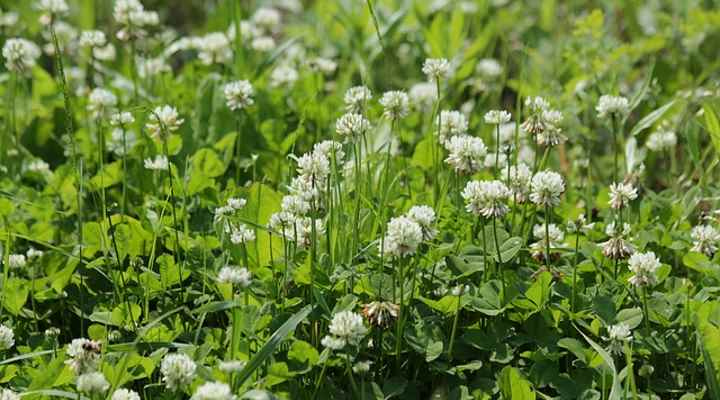
White clover produces creamy white flowers and spreads through the grass
White clover is an invasive flowering weed that forms a thick mat of green foliage and white flowers. Its identifying features are its trifoliate leaves and globular white flowers that emerge in spring. This white-flowering noxious weed spreads by stolons that root in the ground, making it difficult to eradicate from lawns and grassy areas.
White clover grows 3” to 6” (7.5 – 15 cm) tall and up to 24” (60 cm) wide. Although many gardeners consider white clover an annoying spring weed, it has benefits for lawns and gardens, attracting pollinators and acting as a nitrogen fixer in poor soils.
In some cases, clover plants make a great lawn alternative, thriving in areas where regular turfgrass cannot grow.
How to control white clover
The best way to control white clover in a lawn is to keep turfgrass healthy and well-fertilized. White clover thrives in nitrogen-deficient soil. Therefore, keeping healthy levels of nitrogen will prevent white clover weed from thriving. Like most pesky lawn weeds, you can pull clumps of white clover out by hand.
Chickweed (Stellaria media)

Common chickweed is an invasive weed with small white flowers that spreads through the lawn
Chickweed is an annoying creeping lawn weed with low-growing, mat-forming foliage and small white flowers. The dainty white flowers have five two-lobed petals forming a ray around a greenish center. This weedy creeping plant grows and flowers through the year, thriving in full sun and partial shade.
Chickweed is identified by its white star-shaped flowers that can cover lawns and grassy areas. The noxious weed grows up to 20” (50 cm) tall and 12” (30 cm) wide. It becomes a severe nuisance in healthy lawns as it spreads through vigorous roots.
How to control chickweed
The best way to control chickweed is to have good lawn care practices. Chickweed prevention is effective by letting the grass grow longer, watering it deeply, and applying a natural pre-emergent herbicide like corn gluten meal in the spring.
Hairy Bittercress (Cardamine hirsuta)
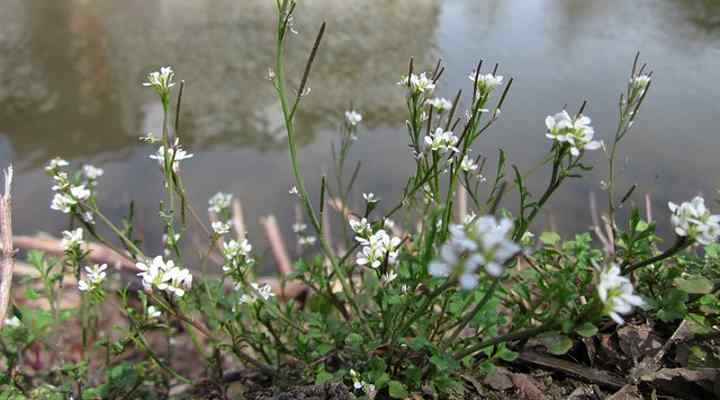
Hairy bittercress weed is identified by little white flowers growing on stems emerging from the grass
Hairy bittercress is a pesky white-flowering shallow-root weed with tiny star-shaped white flowers growing on stems. Identifying features of hairy bittercress are its small green leaves growing close to the ground and white flowers with cross-shaped petals emerging in spring. A single plant can produce thousands of seeds per season.
Hairy bittercress can become a nuisance in lawns throughout the year. The invasive weedy broadleaf plant thrives in sparsely planted lawns, full sun, and damp soil. The white flowering stems measure 3” to 10” (7.5 to 25 cm) tall, forming small clumps of weedy leaves.
How to control hairy bittercress
Keeping your lawn lush and healthy is the best way to control hairy bittercress. Also, removing the plants before they flower helps prevent the weed from taking over your lawn.
Daisy (Bellis perennis)

The white flowering daisy can become a weed when it aggressively invade lawns
Daisies can become annoying perennial weeds in lawns because of their hardiness, rapid growth, and sprawling nature. The low-growing plants have characteristic ray flowers consisting of small white petals surrounding a yellow central disk. These contrast with mat-forming spatula-shaped leaves growing in a rosette pattern.
Daisies thrive in full sun or partial shade and grow 3” to 6” (7.5 – 15 cm) tall and up to 9” (23 cm) wide. Despite being a nuisance in lawns, daisies have beneficial uses in garden landscapes. For example, they are good for white-flowering ground cover in full sun, edging, or planting in containers.
However, daisies are self-seeding and are difficult to eradicate from lawns once established.
How to control daisy weeds
Removing daisies with a daisy grubber is the best way to stop them from spoiling your lawn’s appearance. Because they thrive in full sun, keeping turfgrass thick and healthy will prevent vigorous daisy weeds from taking over.
Wild Carrot or Queen Anne’s Lace (Daucus carota)
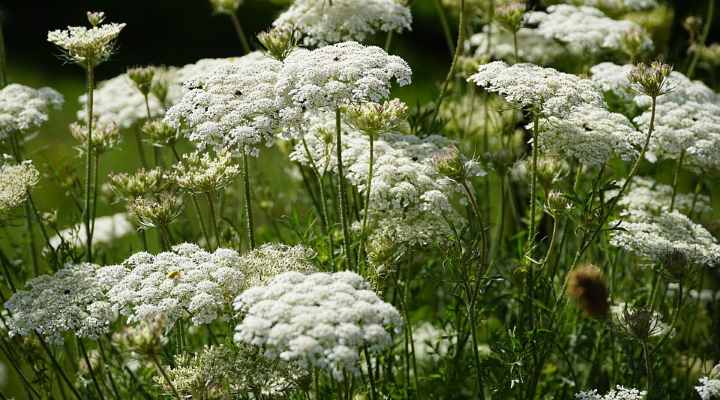
Wild carrot self seeds easily in grass and lawns and produces flat topped white flower clusters on tall stems
Wild carrot lawn weeds are known for their lacy foliage and small white flowers that form flat clusters (umbels) at the top of stems. The plant becomes weedy when it produces thousands of seeds easily dispersed in the wind. This makes it difficult to control wild carrot infestation in lawns and gardens. In addition, wild carrot thrives in dry, infertile locations.
Wild carrots become difficult to remove from lawns and grass plots when they develop a large carrot-like taproot. The weeds can grow 2 to 4 ft. (0.6 – 1.2 m) tall, and the white flower clusters are 2” to 4” (5 – 10 cm) in diameter.
How to control wild carrot
The best control method to stop wild carrot weeds from spreading is to make growing conditions inhospitable for the unwanted plant. Therefore, fertilize turfgrass regularly to ensure fertile soil and keep it moist. In addition, remove the basal rosettes from lawns as soon as you notice them.
Horseweed (Erigeron canadensis)
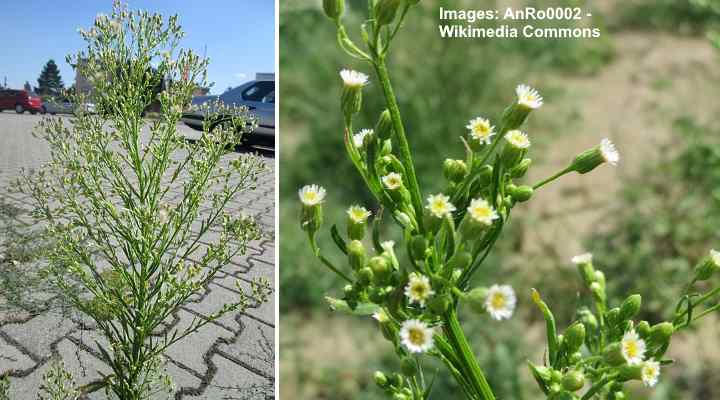
The white flowering horseweed is a vigorous weed that is tough to remove from grassy areas and lawns
Horseweed is a white flowering lawn weed that forms a rosette of hairy, lanceolate leaves in lawns. The weed’s creamy-white flowers are little pea-sized blooms with yellow centers growing in dense clusters. This hardy winter annual weed thrives in even the toughest conditions and typically germinates in the fall.
Horseweed is a significant problem in many lawns because it adapts well to various soil types and has a strong, fibrous root system that’s difficult to remove entirely. In addition, the weed regrows easily from broken stems and is resistant to some post-emergent herbicides.
Horseweed emerges as a flat basal rosette with lance-shaped leaves. However, if left in turfgrass, the vigorous weed grows up to 7 ft. (2.1 m) tall and 2 ft. (0.6 m) wide.
How to control horseweed
Vigilance is key to controlling tough weeds like horseweed. Therefore, use a trowel or a hori hori tool to remove as much white taproot as possible. This is best done during the rosette stage. It is also vital to avoid mowing the shoots at the base, as this will encourage more stems to grow.
Like controlling most lawn weeds, remove the plant before flowers develop, so that seed heads do not form.
Pearlwort (Sagina procumbens)
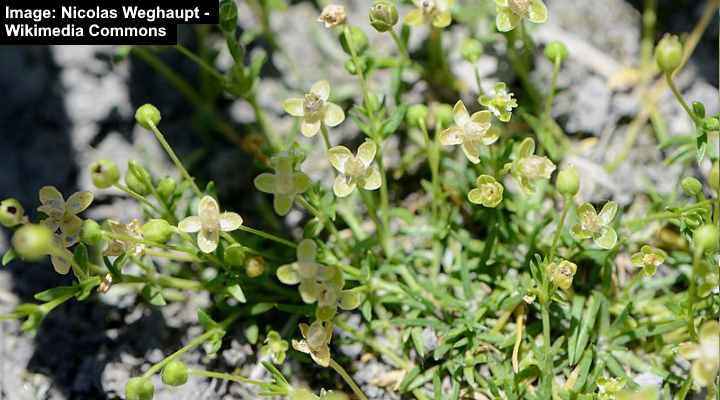
Pearlwort weed can be recognized by its tiny greenish-white flowers growing on creeping stems
Pearlwort is a cool-season annual weed identified by its delicate creamy white ray flowers, awn-like leaves, and bushy clumping nature. Sometimes, the white-flowering weed can look like moss on lawns. The annoying lawn weed spreads through creeping stems with nodes that root in almost any soil type, especially wet, moist soils.
Pearlwort spreads along the ground, only growing around 2” (5 cm) tall. The invasive weed blooms from April through September with little white flowers on the end of long creeping stems. Additionally, pearlwort produces hundreds of seeds that spread when mowed or walked on, making it difficult to control.
How to control pearlwort
The best way to prevent pearlwort from spreading is to keep your lawn at an appropriate height and regularly remove any weeds you may find. Typical control methods include hand-pulling the persistent weeds to keep your lawn healthy and free from pearlwort invasions.
Mayweed (Anthemis cotula)
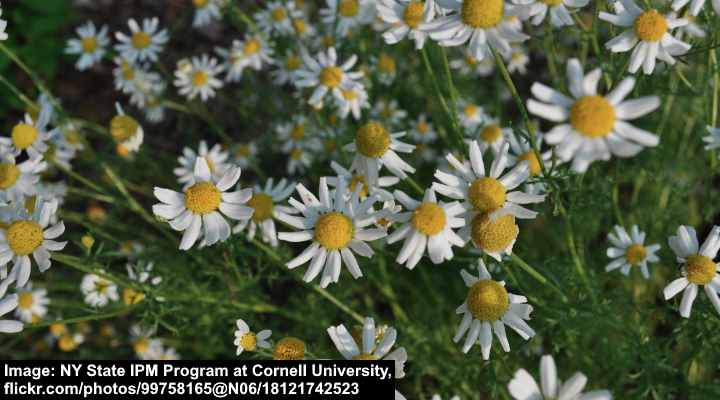
Mayweed is a common lawn weed with white flowers and yellow centers that resemble chamomile flowers
Mayweed is a common fast-growing lawn weed with white flowers that look like chamomile flowers. The white and yellow flowers grow on the ends of branching upright stems. A characteristic of mayweed is the strong odor the plant emits—hence the other name, stinking chamomile.
Mayweed plants have fern-like, feathery leaves measuring 1” to 2” (2.5 – 5 cm) long and growing oppositely on stems growing 12” to 24” (30 – 60 cm) tall. The small white flowers with yellow centers measure 1” (2.5 cm) across, making the weed easy to recognize in a garden landscape.
Mayweed plants are easily spread by numerous seeds the plant distributes after flowering. Therefore, it can become a nuisance if left unchecked.
How to control stinking mayweed
Hand-pulling and digging out the extensive fibrous roots can help remove individual plants from lawns. Removing stinking chamomile before it goes to seed is also important, as a single plant can produce up to 17,000 seeds.
It’s good to know that mowing mayweed is ineffective as it encourages prostrate growth, where the weed produces flowers below the height of a mower blade.
Yarrow (Achillea millefolium)
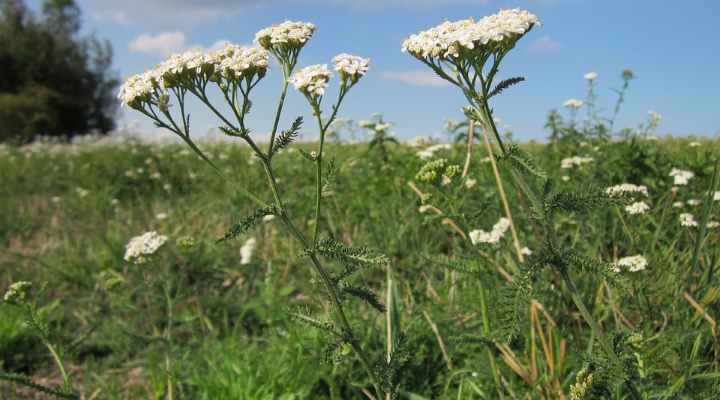
The flowering common yarrow weed produces white flat-topped flowers and it has feathery leaves
Yarrow is a herbaceous perennial white-flowering plant with weedy tendencies. Identifying features of this tall weed are its large clusters of flat-topped white flowers, feathery fern-like foliage, and hairy stems. Although yarrow is useful in a garden landscape as ground cover for full sun, it becomes a lawn weed if it takes root in turfgrass.
Yarrow grows 2 to 3 ft. (0.6 – 1 m) tall and wide. Its white blossoms measure 2” to 4” (2.5 – 10 cm) across and brighten spring and summer gardens. However, its vigorous growth in lawns typically survives mowing where it regrows from underground creeping stems, making it a pest in turfgrass. In addition, yarrow can outcompete grass blades and leave bare patches in lawns if left unchecked.
How to control yarrow
Like most lawn weed control methods, physically removing the plant’s roots as much as possible is the best way to get rid of it. Unfortunately, this may mean digging out chunks of lawn and reseeding it.
Additionally, maintaining a healthy lawn is an effective preventative method for yarrow. Therefore allow grass to grow longer to provide shade at soil level and fertilize regularly to encourage thick growth.
Black Nightshade (Solanum nigrum)
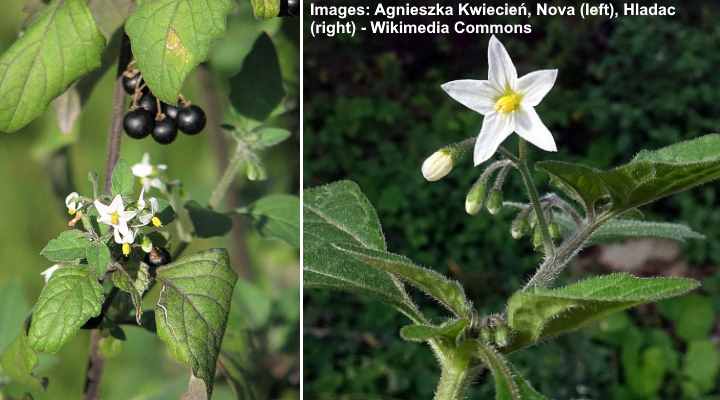
Black nightshade weed is characterized by its star-shaped white flowers and black berries and is considered less invasive than other weeds
Black nightshade is a noxious annual weed found in lawns and gardens throughout the United States. Characteristic features of black nightshade are its five-petalled star-shaped white flowers, rough stems, and purplish-green egg-shaped leaves. The weed also produces small, purplish-black berries.
Black nightshade is common in garden lawns and flower beds. This white-flowering weed grows 4 ft. (1.2 m) tall. Unlike many other lawn weeds, this species spreads through seeds the birds distribute after consuming the berries. Therefore, it’s not as fast-spreading or invasive as other lawn weeds.
How to control white weed in grass
Removing black nightshade in the garden is possible by digging the plant’s roots out of the ground. Unfortunately, most natural weed killers and herbicides are ineffective at eradicating nightshade.
Stinging Nettle (Urtica dioica L.)
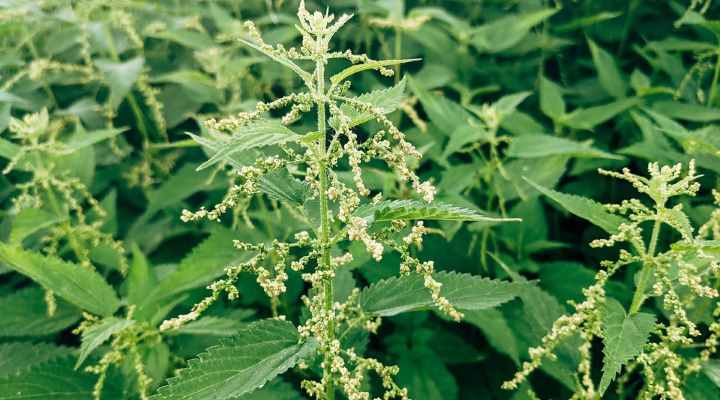
Stinging nettle is known by its irritating leaves but also produces creamy-white or greenish tiny flower clusters
Stinging nettle is a wild-growing, invasive white-flowering weed that can find its way into lawns and flower beds. The most recognizable feature of this nettle weed is its hairy leaves that irritate the skin on contact. However, the weedy perennial plant also produces small clusters of white-green flowers at right angles to the upright stems.
Stinging nettles germinate in spring and spread via underground rhizomes, making them difficult to eradicate entirely. The stinging weeds can grow around 3.5 ft. (1 m) tall in gardens. However, they can reach 10 ft. (3 m) tall in undisturbed natural environments.
How to control stinging nettle
Hand-pulling stinging nettle plant roots is the best way to manage these irritating weeds. Remember, wearing gloves is vital to prevent skin irritation from stinging hairs. To control stinging nettle, it’s also important to ensure that the rhizomes are removed from the ground; otherwise, they may regrow fairly rapidly.
Related articles:
